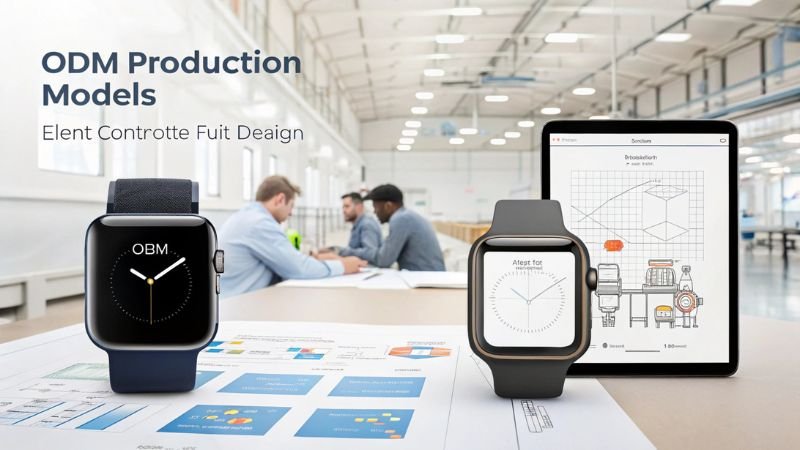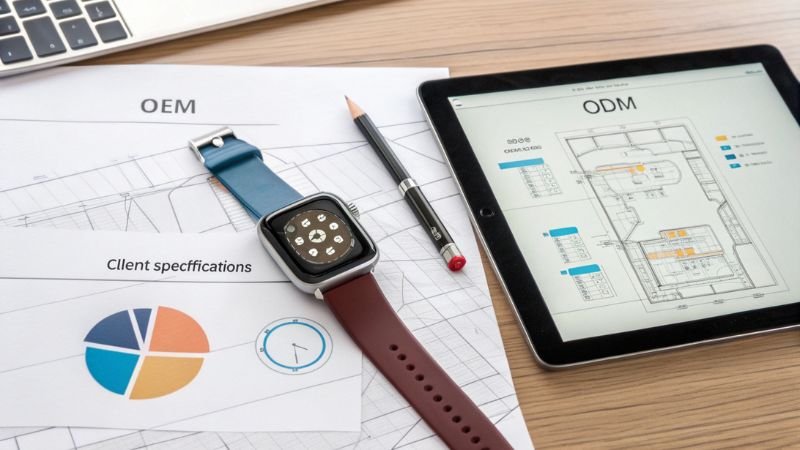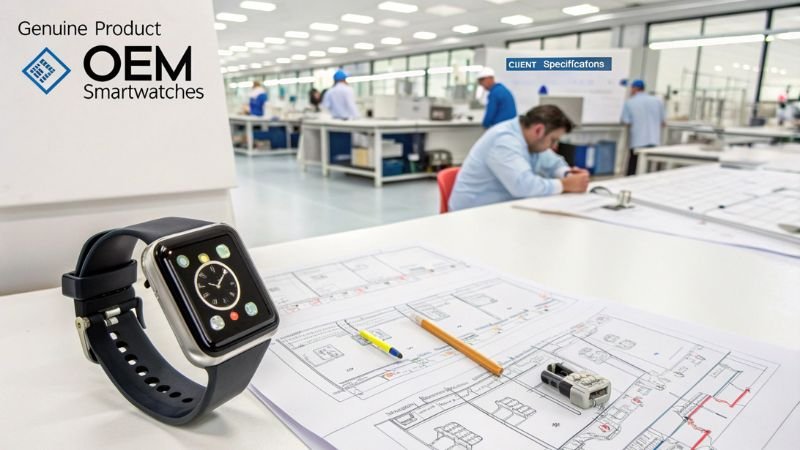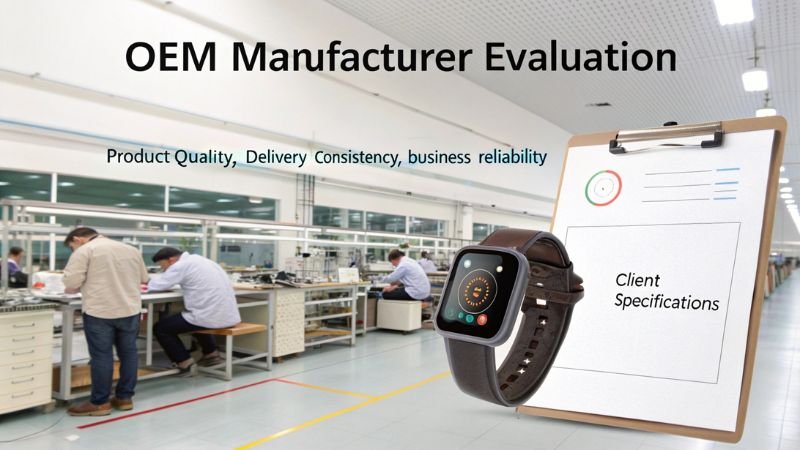How to Choose Between OEM and ODM for Smart Watch Production?

For distributors, wholesalers, business owners, importers, e-commerce sellers, Amazon or Shopify sellers, and tech entrepreneurs looking to bring smartwatches to market, choosing the right manufacturing model is critical. OEM (Original Equipment Manufacturer) and ODM (Original Design Manufacturer) are the two primary production models in the smartwatch industry, each offering distinct advantages and challenges. Whether you’re launching your own smartwatch brand or expanding your product line, understanding how to choose between OEM and ODM can significantly impact your costs, product quality, and time to market.
This guide breaks down the key differences between OEM and ODM, helping you decide which manufacturing model best aligns with your business objectives and resources.
1. OEM vs. ODM: Which Manufacturing Model is Best for Your Smart Watch Business?
The decision between OEM and ODM depends largely on your business’s specific needs, including product design, branding, and budget. Below is an overview of the key characteristics of each model to help you choose the best fit for your smartwatch business.

OEM (Original Equipment Manufacturer)
OEM manufacturing allows you to take full control over your smartwatch’s design, features, and branding. In this model, you provide the design specifications, and the manufacturer produces the product according to your exact requirements.
When to Choose OEM:
- You have a unique design or specialized features you want to offer your customers.
- You want full control over the product quality, design, and branding.
- Your business is established, and you have the budget and resources to invest in product design and development.
- Quality and differentiation are top priorities for your brand.
Advantages of OEM:
- Complete Design Control: You own the design and branding process, allowing you to create a unique smartwatch that stands out in the market.
- Customization: Full flexibility to customize both hardware and software features according to your needs.
- Brand Exclusivity: OEM products are exclusively branded, giving your business a distinct identity.
Challenges of OEM:
- High Upfront Costs: Creating a custom design can be expensive, requiring investment in R&D, prototyping, and testing.
- Longer Time to Market: The design and manufacturing process takes longer since you are involved in the creation and iteration of the product.
- Increased Complexity: OEM production requires more involvement in quality control and manufacturing processes.
Example:
I decided to work with an OEM1 for my smartwatch line because I had a unique design in mind. This gave me full control over the product’s features and branding, but I also had to invest significantly in development. The result was a distinctive smartwatch that perfectly matched my brand’s vision.
ODM (Original Design Manufacturer)
ODM manufacturing offers a more streamlined production model. In this case, the manufacturer already has pre-designed smartwatches that you can customize with your brand name, logo, and some features. The designs are owned by the ODM, and you can modify them to suit your target market.
When to Choose ODM:
- You’re a startup or have a smaller budget for design and production.
- You need a faster time-to-market with a product that already exists and can be easily customized.
- You lack design expertise but still want to create a unique product with your branding.
- You want a lower upfront cost and are okay with using an existing design that may have limited customizability.
Advantages of ODM:
- Lower Costs: ODMs provide pre-designed products, reducing the need for heavy investment in R&D or product design.
- Faster Production: With existing designs ready for customization, the manufacturing process is much quicker, allowing for faster time-to-market.
- Design Flexibility: Some customization options are available, such as color, material, features, and packaging, allowing you to put your brand’s stamp on the product.
Challenges of ODM:
- Limited Design Ownership: Since the designs are pre-existing, you have less control over the final product’s features and aesthetics.
- Branding Overlap: Other businesses may also be using the same ODM design, so differentiation becomes a challenge.
- Less Customization: While customization is possible, it may be more limited than with OEM.
2. How Does OEM Manufacturing Impact Smart Watch Costs?

One of the biggest differences between OEM and ODM is the cost structure. OEM manufacturing typically involves higher upfront costs compared to ODM. Here’s how:
Cost Breakdown of OEM Manufacturing:
- Design Costs: You will need to invest in product design, prototyping, and technical development, which can be expensive.
- Tooling and Setup Costs: Custom manufacturing requires specialized tools and machinery, which adds to the overall cost.
- Minimum Order Quantities (MOQ): OEMs typically require higher MOQs, which can be a barrier for smaller businesses.
- R&D Investment: If you want unique features or specialized software, you may need to invest in research and development, driving up costs.
Impact on Business:
- Higher Product Price: The higher costs involved in OEM manufacturing typically lead to a higher cost per unit. This means your retail price will also likely be higher, which can impact your pricing strategy.
- Investment Risk: If your product doesn’t sell as expected, the initial investment in design and manufacturing can represent a significant risk for your business.
- Potential for Higher Margins: If successful, an OEM product allows for better margins, as you control the production process and avoid sharing profits with a third-party designer.
3. Can ODM Smart Watch Manufacturing Work for Small Businesses?

Yes, ODM can be an excellent choice for small businesses, especially those that need to scale quickly without incurring high initial costs. Here’s how ODM can benefit smaller businesses:
Advantages for Small Businesses:
- Lower Upfront Investment: Since you’re using a pre-designed product, there’s no need to spend heavily on R&D, design, or prototyping.
- Faster Time-to-Market: With the design already developed, you can bring your smartwatch to market faster, which is essential for smaller companies looking to stay competitive.
- Less Risk: By using a proven design, you reduce the risk of a product failing in the market because the product has already been tested and is in production.
- Customization at a Lower Cost: You can still personalize the product to a degree, choosing colors, features, and packaging that fit your brand, at a lower cost than designing a smartwatch from scratch.
Potential Limitations for Small Businesses:
- Limited Differentiation: If other brands are also using the same ODM design, you may struggle to differentiate your product.
- Control Issues: You may have less control over the final product, especially when it comes to design or feature adjustments.
4. Are OEM Smart Watches Genuine or Knockoffs?
OEM smartwatches are typically genuine and authentic products, not knockoffs.

Why OEM Smartwatches Are Genuine:
- Custom Designed: In an OEM model, the client provides the design specifications and owns the intellectual property. This ensures that the product is original and tailored to the client’s needs.
- Manufacturing Quality: Reputable OEM manufacturers adhere to strict quality control standards, ensuring the authenticity and durability of the product.
- Legitimate Branding: The branding, logo, and product features are all developed by the client, ensuring that the product is marketed as a genuine product under the client’s brand.
Caution Against Knockoffs:
- Knockoffs usually refer to counterfeit products that copy an existing brand’s design. OEM smartwatches, on the other hand, are built with the permission of the client, making them legitimate.
5. How to Evaluate and Select Reliable OEM Smart Watch Manufacturers?

Choosing a reliable OEM smartwatch manufacturer is essential to ensure high product quality, consistent delivery, and a smooth business relationship. Here are the key factors to evaluate when selecting an OEM manufacturer:
1. Manufacturing Experience and Reputation:
- Look for manufacturers with experience in producing high-quality smartwatches and a strong reputation in the industry. Check reviews, case studies, and client feedback to verify their track record.
2. Quality Control Standards:
- Ensure the manufacturer adheres to strict quality control processes, including product testing and certification. This will help ensure that your products meet international quality standards.
3. Production Capacity:
- The manufacturer should be able to handle your required production volume, whether it’s small or large-scale. Consider MOQs (Minimum Order Quantities) and ensure they can meet your timelines.
4. Communication and Transparency:
- A reliable manufacturer should provide clear communication throughout the production process, addressing your questions, offering insights, and resolving issues quickly.
5. Customization Capabilities:
- Assess how much flexibility the manufacturer offers in customizing the design, features, and branding. Some manufacturers may offer limited customization, while others allow extensive modifications.
6. Intellectual Property Protection:
- Ensure that the manufacturer is committed to protecting your intellectual property, especially if you’re designing a unique product. Look for non-disclosure agreements (NDAs) and patent protection.
7. Competitive Pricing:
- Evaluate the pricing structure to ensure it fits within your budget while offering a competitive cost per unit. Remember, cheaper is not always better—focus on value for money, including quality and service.
Conclusion
Choosing between OEM and ODM for smartwatch production depends on your business size, budget, and long-term strategy. OEM offers full design control, brand exclusivity, and the potential for high margins, but requires a larger upfront investment and a longer time-to-market. ODM is ideal for smaller businesses or startups looking for a cost-effective, faster solution with some flexibility in product customization. By understanding the unique characteristics of each manufacturing model, you can make a more informed decision that aligns with your business goals and resources
-
What are the benefits of choosing OEM in manufacturing? – Discover the advantages of choosing OEM for your smartwatch business, such as full design control and brand exclusivity. ↩


